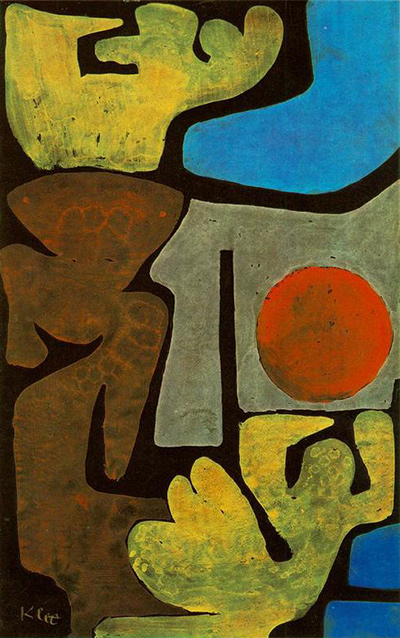One of Klee’s most famous works is a painting he did in 1939, known as Park of idols
Painted on a blackened paper using watercolour, the work consists of three idols of distinct shapes and colours.
Given that Paul Klee’s creative works during this period were mainly premised on demons and angels, the title “Park of Idols” triggers a series of questions in any art enthusiast’s mind.
You wonder what kind of “idols” they are and what kind of “park” they are in.
The three idols clearly identified from the painting have distinct colours which can’t be described as mouldy but pearlescent. There is a round ball-like object in the painting which represents the sun and the background is portrayed in grey-blue and blue colours.
The sun in the picture is clearly not meant to look like a heavenly body but is portrayed as a worship idol, together with the other idols in reddish brown and greenish yellow colour.
The black landscape against which the painting is done elicits different feelings from the viewers. The gaps left between the idols through which the black background can be clearly seen might be paths or just nothingness.
They give the painting a unique mystical quality. It is true that most things look different in black, and can be interpreted differently based on an individual’s thinking. The black background was quite perfect given that if the idols were to be painted on any other background, their placement wouldn’t be that striking.
Paul Klee was a true master of colour theory and vastly wrote about it. Klee who taught in German Bauhaus School of Art, Design and Architecture employed his comprehensive skills to mentor many upcoming artists.
Paul Klee can be described as a natural craftsman, who mostly researched and experimented in attaining new combinations of colour, which most of the time came in ordinary and glossy forms. He produced several paintings from the early 1900s up to the time he died in 1940.
A Swiss painter of German descent, Paul Klee‘s unique and slightly humourous works are full of allusions to music, dreams, and poetry.
The artist who was born in 1879 and died in 1940 had an exceptionally personal style which was inspired by surrealism, cubism, and expressionism. He is also known to have been a student of the oriental school.




